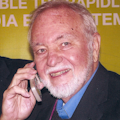Test and measurement is an essential part of any engineering discipline. But as the wireless and communications arenas explode, old technologies are finding new applications. In particular, National Instruments' 20th anniversary edition of Lab-VIEW and the Tektronix RSA6100A real-time spectrum analyzer will change the way we test, as well as the way we communicate.
LABVIEW 8.20
Back in 1976, none of us had ever heard of the virtual instrument concept, a category virtually invented by National Instruments. Yet when LabVIEW first was implemented on the Apple Macintosh, it became a big hit. In fact, Electronic Design announced the first edition of LabVIEW on the cover of its April 17, 1986 issue. Today, LabVIEW is an industry icon.
The LabVIEW graphical programming language lets designers build programs by wiring together icons on the screen. The icons compile into code that processes the data. Internally, NI calls the language G, or graphical programming language. It's based on two fundamental programming concepts, data flow and structured programming.
LabVIEW's real value is its ability to quickly develop virtual instruments (VIs) and acquire, process, and display measurements from sensors and other inputs. With LabVIEW and a PC, designers can create their own special data acquisition system or replace standard test instruments like digital multimeters (DMMs) and oscilloscopes with a few clicks of the mouse.
Users can acquire and display data, as well as subject it to a wide range of mathematical processes to analyze, display, and understand it. Then, users can communicate the data through communications interfaces, networks, or the Internet. Furthermore, they can use the outputs of the VI to perform various control operations. LabVIEW has gradually morphed into an all-purpose graphical measurement system that's useful in design, prototyping, and final test.
Virtual instrumentation, and particularly LabVIEW, has changed the test and instrumentation landscape by completely eliminating some types of standalone test instruments (e.g., audio). Today, LabVIEW addresses the growing wireless test and measurement challenge facing so many organizations.
Version 8.20's new Modulation Toolkit is a collection of software that lets you build, simulate, design, and test all kinds of communications systems (Fig. 1). It includes orthogonal frequency-division multiplexing (OFDM) that is being used in most of the newer wireless systems like 802.11a/g, 802.11n, WiMAX, and the forthcoming 4G cell phone standards. During simulation, you can evaluate parameter changes and test your design decisions. Then later you can use that code with external test instrumentation to perform signal measurements and bit error rate (BER) tests.
Some of the specific features of the Modulation Toolkit are bit generation (PRBS, Galois PN, Fibonacci PN, etc.), channel coding (Reed Solomon, Golay, Hamming, convolutional, BCH), interleavers (block and convolutional), and most forms of analog or digital modulation. You can perform a variety of modulation analysis including rho, dc offset, phase error, quadrature skew, IQ gain imbalance, BER, frequency deviation, burst timing, modulation error ratio, and error vector magnitude (EVM).
In addition, you can add noise (AWGN or phase) and impairments such as dc offset, fading, quadrature offset, IQ gain imbalance, and frequency offset to the simulated channel to evaluate performance. Then you can use any one of a number of display formats such as trellis diagrams, constellation plots, and 2D/3D eye diagrams.
LabVIEW 8.20 also contains the FPGA Module, which will help you define custom I/O without knowledge of hardware design or VHDL. The FPGA Wizard automates the development of FPGA code for building custom, user-defined measurement devices. You can implement FPGA-based measurement devices on plug-in boards in a PC for fast, low-cost prototyping or in an NI PXI module for formal production test. This feature includes IF-RIO (intermediate frequency, reconfigurable I/O) that includes two IF digitizers, two IF generators, and an FPGA that is programmed via LabVIEW on a single PCI board. By using IF-RIO you can prototype communications systems and then run them in real time on a PC. Finally, the Modulation Toolkit works with NI's family of RF generators and receivers for implementing a variety of test instruments up to 2.7 GHz.
TEKTRONIX RSA6100A
All communications and wireless engineers need the best spectrum analyzer they can afford, and Tektronix's RSA6100A real-time spectrum analyzer really stands out (Fig. 2). Whether you're testing advanced radio technologies like software-defined radio (SDR), 4G cell phone and broadband wireless, multicarrier power amps, radar, or any other communications or wireless device, this analyzer brings some useful new features to the breed.
For example, it accelerates the spectrum measurement and display by making 48,828 measurements per second, compared to only 50 per second for competitive models. This provides a more complete and accurate picture of the signal.
Second, the RSA6100's DPX waveform image processing capability makes the display come alive. It provides changes in intensity and color, in addition to the traditional display, so users can see transients and other signals that typically don't appear on other analyzers.
And with the DPX frequency mask trigger (FMT), users can initiate a measurement based upon the appearance of a unique event or pattern of events. With this feature, users also can capture elusive anomalies and transients that improve productivity and speed up design and debug.
The basic specs are also impressive. The RSA6100A provides 110-MHz real-time bandwidth simultaneous with 73-dB spurious-free dynamic range (SFDR). The RSA6106A offers a frequency range to 6.2 GHz, and the RSA6114A has a frequency range to 14 GHz. These are high-ticket products, but as they say, you get what you pay for. The best products produce the best designs faster.
About the Author

Louis E. Frenzel
Click here to find more of Lou's articles on Electronic Design.